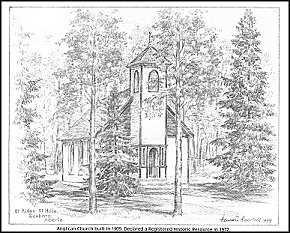 Between the years 1903 and 1910 several English settlers had taken up homesteads in the area that came to be known as the Rexboro district. Realizing that the wilderness that they had chosen for home, would not become the civilized community they envisioned without the institutions they had learned to cherish, these pioneer men and women planned the building of this church.
Between the years 1903 and 1910 several English settlers had taken up homesteads in the area that came to be known as the Rexboro district. Realizing that the wilderness that they had chosen for home, would not become the civilized community they envisioned without the institutions they had learned to cherish, these pioneer men and women planned the building of this church.Other features were added gradually. The lectern, kneeling desk and altar rail are the work of Alf Broadhurst. Mr. Beckett, of Darwell, donated the pulpit which he made. He also donated his labour in the making of the pews. The material was paid for by members of the congregation, some as memoriams. At the end of World War 1, Mrs. M.H. Walker, of London, England, gave the bell and belfry in memory of her youngest son, who died in that war (1917). Through the years various items, which have enhanced the simple beauty and added interest for those who worship at the Rexboro Church, have been donated.
Rev. Walter Leversedge, who later became Archdeacon Leversedge, was the first parson. He was followed by Rev. Huxtable, a young Englishman, who made parish visits riding on an Indian pony which had not been trained according to the conventions of an English riding academy. Rev. Teale arrived in 1914, but after a short stay, enlisted for overseas service. The parish was served in the years before 1912 by parsons who worked from the Wabamun mission. Rev. Blood, Rev. Harkness (with his skill for organizing "work bees") Rev. Mathers, Rev. Wilson, Rev Greenstreet and Rev. Farnham. After the Wabamun mission was destroyed by fire (1924), parsons from Onoway served the parish for some time until the church and rectory were rebuilt at Wabamun. The early ministers serving the parish, were, in the main, a hardy lot. They travelled by horse and buggy or sleigh in fair weather and foul, over trails that served as roads, but often they rode horseback or walked to keep their appointments.
Later, with Wabamun restored as the mission headquarters and roads considerably improved, parsons there included St. Aidan and St. Hilda as part of their responsibilities in a larger field. Among these ministers was Rev. Colin Cuttell, now Canon of All Hallows, London, who served this parish from 1937 to 1942, and made a notable impact on the work of the church. During the last years the church has been served by the incumbent at Onoway, with the help of Edmonton parsons and lay readers during the summer months.
St. Aidan and St. Hilda church was built to be a centre of faith and inspiration to a pioneering community. Today, hundreds race by on a modern highway. The church, still in its same idyllic setting, stands not only as a memorial to its builders and its faithful workers, but also as a reminder to vast numbers, of the Christian values and ideals upon which our way of life was founded.
Districts, Villages and Points of Interest